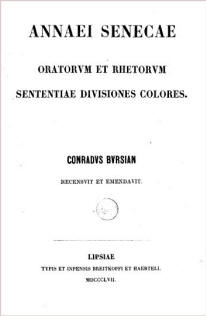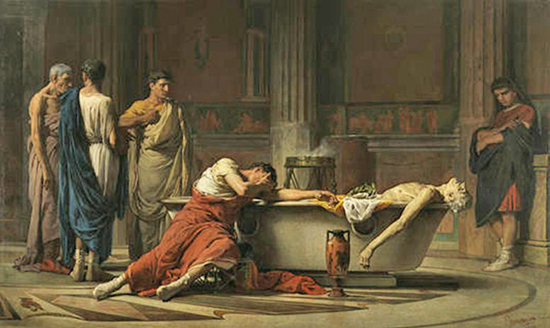|

Seneca 4 BC - AD 65
Lucius
Annaeus Seneca, also called
Seneca the Younger, was
a Roman politician, a philosopher, and orator. He also wrote
several philosophical works as well as tragedies.
|
|
Image Above
Marble bust of
Seneca, back to back with
 Socrates.
Socrates.
Bust created
around 3rd century.
Staatliche Museen
Berlin |
Seneca's Family
Secena's family was more than
well-off. They called Corduba, or Córdoba, in southern Spain, their home.
Corduba had been occupied by the Romans since 152 BC.

Roman Bridge,
Córdoba, Spain
Photo Jim Gordon. Map
Wiki.
Seneca's father was
Lucius Annaeus Seneca, Sr.
also called Seneca the Elder.
Seneca the Elder was born at Corduba in the fifties BC. He
is well-remembered for his work Oratorum et rhetorum sententiae divisiones colores,
or in other words Sentences, Divisions, and Colors of the
Orators and Rhetoricians.

Intellectual Output — Seneca Sr.
Seneca's mother was
Helvia.
Seneca the Elder and Helvia had three sons:
|
 |
The oldest son was
Lucius Annaeus
Novatus, who became
Junius Annaeus Gallio,
after his adoption by the Roman Senator and
rhetorician Junius Gallio, who had been a
good friend of Seneca the Elder.
Gallio Jr. became an excellent orator, as well as
proconsul of Achaea in Greece, in which
capacity he met the Apostle Paul.
Seneca Jr.
wrote his work De Ira (On Anger) in
the style of a
letter written to his brother Novatus.
Gallio was
born around 5 BC. |
| |
|
|
 |
Seneca Jr.,
who would become known as Seneca the
philosopher, was the second son.
He was born around 4 BC - AD 1. |
| |
|
|
 |
The youngest son
was Lucius Annaeus Mela, who
became the father of the poet
Lucan. |
Seneca's Early
Years
Seneca the Elder moved his
entire family to Rome when Seneca Jr was still a child. This
was in order to secure his sons a Roman education and
hopefully a fruitful career in Roman politics.
Seneca Sr.
hooked the boys up with the finest tutors, and wee Seneca advanced in philosophy, rhetoric, and law.
But son Seneca's feeble health,
probably tuberculosis and asthma, made him semi-suicidal and
prompted a visit to aunt and uncle Gaius Galerius in Egypt
to restore both his mental and physical health.
Who Ruled at the Time?
In his lifetime, Seneca
witnessed the
reign of the following emperors:
Seneca's Career
in Rome
Surviving a shipwreck and seeing his uncle drown
didn't help in his struggle against dark moods, but Seneca was the sturdy intellectual type.
Back from Egypt in 31, Seneca was ready for his
career as a Roman politician.
He became a quaestor
(lowest ranking regular magistrate in ancient Rome) and
entered the Senate.
Seneca also got married,
probably to Pompeia Paulina,
who survived him.
Thanks to his exceptionally bright
mind, Seneca climbed the career ladder swiftly and excelled as
a skilled orator.
With a jealous eye, Emperor Caligula
observed Seneca's rise to fame and wanted him eliminated. What saved Seneca's hide?
Some historians believe that Seneca saved his life
by means of his outstanding oratorical talent. Others say, Caligula
reflected for a minute on Seneca's poor health and let him
be as his poor physical shape would lead to his demise soon
enough.
Whatever the case, Caligula
himself eventually expired in AD 41, aged 28.
|
But Seneca couldn't catch a
break. Caligula's uncle and successor, Emperor Claudius,
became
convinced that Seneca had an affair with his, Claudius',
niece, Julia Livilla. So he sent Seneca into exile on Corsica.
And there were worse
exile destinations. The island of Corsica was, and still is,
one of the most beautiful places in Europe.
Here is more on
 Corsica.
Corsica.
|

Jenny
White is
Julia Livilla in the 1968
series The Caesars |
Julia, by the way, was also sent into exile. Her one-way
ticket took her to
the island of Pandateria, today's Ventotene, where she died
in the year 41 or 42.
Did Seneca and Julia actually
have an affair? Probably absolutely not.
What was at the root of this
mess?
|

Merle
Oberon is
Messalina Valeria in the
1937 movie I, Claudius |
The trouble had a name. It was
Messalina Valeria,
third wife of Emperor Claudius. This marriage
had ended in AD 40, placing this experience in Claudius'
pre-emperor column.
And if you liked Joan Collins' Alexis, you enjoy Messalina, who was
twice the bitch and not even acting. It was thanks
to her and her web of neatly weaved intrigues, that Seneca
found himself on the ferry to Corsica. |
Seneca's father
and his son had just recently died, and life was all about
getting back up at this point.
Although Seneca asked for clemency, he
had to sit tight for 8 long years. It took the execution of
Messalina in 48, and the wedding of Emperor Claudius' to a new
wife, Agrippina, before, in 49, Seneca was allowed to return to Rome.
Agrippina, by the way, who was
also called Julia Agrippina, or Agrippina the Younger, was Claudius'
niece (the sister of Julia Livilla). She turned out to be the schemer behind
Messalina's death, thus proving to be quite the handful herself.
Back to Seneca.
Seneca was allowed to continue his political career.
In AD 50, he became praetor
(powerful judicial officer in ancient Rome)
and was again well-established and mostly content.
That same year, the Emperor
asked Seneca to become the tutor of his adopted son. What
did Seneca find in the nursery? Wee Nero, 12 years old.
Where did he come from?
Seneca and Nero
Nero was the son of Agrippina
and Agrippina's first husband, the Roman consul
Gnaeus Domitius Ahenobarbus, who died in AD 40. Agrippina married
again, this time Passienus Crispus,
one of the most esteemed Roman politicians at the time, whom she served with poison tea and cookies
and whose consequent passing made her a young and enormously wealthy
widow.
Now in her
third marriage — married to the Emperor Claudius, which was Claudius' fourth
marriage, and which, by the way, was incestuous by Roman law — Agrippina was ready to pave the
road for her offspring.
Claudius adopted Nero and,
overlooking his own son Britannicus
(by Messalina) declared Nero heir to
the throne.
Agrippina then manipulated Claudius
into marrying his daughter Octavia
(by Messalina), to her
son Nero.
Nero marrying his stepsister
Octavia could be potentially bad press should someone feel
conservatively with regards to incest. Hence Octavia was legally transferred to
another family, Octavia's previous marriage agreement to one Lucius Junius Silanus
was annulled, and in 53, Nero and Octavia were married.
As far as Agrippina was
concerned, Claudius' work here on earth was done.
It was one October day in the
year 54, when
Claudius didn't return from his afternoon tea with
Agrippina. Nero, only 16 years old, became
the new emperor. The new sticker on the letterbox read
Nero Claudius Caesar Augustus Germanicus
and mother
Augusta Agrippina.
What's an Augustus or an Augusta?
The Latin word augustus means
venerable.
Agrippina
had received the title Augusta in
AD 50, but she couldn't really relax
until her son became Augustus
as well.
In
Agrippina's case, this status elevation
was unprecedented. So far, a Roman first
lady was made Augusta only after her husband had
died. Agrippina was the
first empress who received this
title while her husband was still
alive.
The Romans now had to
salute not only their emperor but also
his wife each morning. Agrippina's head
appeared on
many coins and wherever else she could
manage to place an image of herself. On
some of these images she even sported a
diadem, the symbol reserved to depict a goddess.
Back to
the imperial court.
To tie up loose ends, Britannicus, too, was
invited to one of Agrippina's poisonous tea parties. The last time
Britannicus drew a breath was in the year 55.
Seneca, Burrus, and the Quinquennium Neronis
Thus, Nero ruled together with
his dominant mother, and with the help of Seneca and
Sextus Afranius Burrus, the prefect
of the Praetorian Guard.
Previously, the office of prefect had been occupied by two individuals, but Agrippina thought one
man would be easier to handle, and had influenced her husband
to make changes accordingly.
These two advisers, Seneca and
Burrus, of course, strongly
recommended cutting the umbilical chord.
Which Nero did.
In 56, he retired his mother by
excluding her from official political business.
From 56, marking the year of
Agrippina's forced retirement, until 62, Seneca and Burrus
governed the country from their positions as chief advisers.
 Tacitus, arguably the
greatest historian, says that the working
relationship between Seneca and Burrus "had unanimity rare for men in such
powerful positions."
Tacitus, arguably the
greatest historian, says that the working
relationship between Seneca and Burrus "had unanimity rare for men in such
powerful positions."
The results?
There was only good
behavior on Nero's part, apart from the occasional night of
partying. And there were plenty of swell improvements in
Roman life, society, and its administration. Seneca
wrote Nero's speeches, and yes, Seneca became even
wealthier. Young Nero could be very generous.
This time period of harmony and good goings, the first five years of Nero's
reign, is also called Quinquennium Neronis,
The Five-Year-Period of Nero. It is considered a perfect
pattern of good government.
But trouble was around the
corner.
Seneca Declines
Nero fancied
Poppaea Sabina, and by
AD 58 they were having an affair. Mother Agrippina disapproved while
girlfriend Poppaea Sabina did all she could to convince Nero that
Agrippina had become a liability.
In AD 59, Nero was ready for his
move. Together with Anicetus, a former tutor of Nero's and now prefect of the
fleet at Misenum, a plot was hatched to kill Nero's mother
by sinking her on a boat, thus making it look like an accident.
Although injured, Agrippina survived the incident
by managing to swim to shore.
When Nero heard
the news of her survival, it scared the living
daylights out of him. And rightly so. The types of Agrippina
wouldn't let a personal assassination attempt go unpunished.
Nero sent for Seneca and Burrus,
and explained his predicament.
What to do?
Seneca inquired if Burrus would
be willing to let his boys take care of Agrippina. Negative. Burrus
reminded that his job was the protection of
the royal family, not its elimination. Her family had been
in high standing with the guards. Besides, Anicetus was
the one who failed, he should be the one to clean up this
mess.
Nero then sent Anicetus on his
way to finish the job.
Agrippina's messenger,
Agerinus, who had
come to Rome with the message of Agrippina's "accident", was still waiting to
speak to Nero directly. Nero thought on his feet (although
it was probably Seneca's idea.) When Agerinus entered, Nero threw a sword at his feet, screamed
that his mother had sent an assassin, and had his guards take Agerinus away in chains.
Anicetus and his troops arrived
at Agrippina's country house located at Lake Lucrino, 30
car-minutes from Naples. He surrounded the estate, forced
the gates open, found her at home, and ended her life
with his sword.
Tacitus mentioned that in AD 59
"Nero ceased delaying his long-mediated crime"
indicating that Nero might pondered his mother's
murder once or twice in the past.
Seneca tried to keep Nero's name as clean as he could.
... Seneca
wrote the emperor's speech of
self-exculpation - perhaps the most famous
example of how the philosopher found himself
increasingly compromised in his position as
Nero's chief counsel.
Certainly as a Stoic,
Seneca cuts an ambiguous figure next to
others who made their opposition to Nero
clear, such as Thrasea Paetus and Helvidius
Priscus.
His participation in court politics
probably led him to believe that he could do
more good from where he stood than by
abandoning Nero to his own devices - if he
even had this choice.
Anger, Mercy,
Revenge by Robert A. Kaster and Martha C.
Nussbaum, University of Chicago Press
In June 62, Nero's wife Octavia
conveniently died of poison and Nero was free to marry his
second wife, Poppaea
Sabina.
The year 62 was also the year
during which Burrus died, and poisoning by Nero was a
possible cause. Seneca asked to be retired but
Nero denied the request.
On January 21, 63, Nero and Poppaea
Sabina's daughter Claudia was
born. Nero was delighted, and mother as well as daughter were
declared Augusta. Claudia would remain the
emperor's only child. But the baby died after only four months.
In 64, Seneca asked again to be
sent into retirement, but was denied again.
Seneca's Final Chapter
In 65, Poppaea Sabina died
prematurely, and Nero married Statilia Messalina.
Killed or accident?
By
that time Seneca didn't care anymore because he had run into his
own final
troubles when in the same year the Pisonian Conspiracy
unfolded. The conspirators wanted Nero dead and C. Calpurnius
Piso as replacement.
Seneca's nephew Lucan was
involved in the plot and Nero accused Seneca, who might or might not
have been mixed up in this affair, of conspiracy and ordered him to poison
himself.

After cutting
his veins, Seneca gets into the bathtub
while his sorrowful friends swear their hate
Painting by Manuel Domínguez
Sánchez, 1871
Museo Nacional
del Prado, Madrid
Seneca's Death
Ever the stoic, Seneca followed orders
and opened his veins. His blood flow was slow and Seneca asked for
poison to speed up the process. It still took a long time
for him to die, but Seneca eventually managed.
Pompeia Paulina, Seneca's wife, tried to follow
suit but Nero ordered his guards to prevent her from killing
herself.
Seneca was cremated, and there
was no funeral ceremony.
Pompeia Paulina remained a widow
for the few final years of her life.
"Oderint, dum metuant"
"Let them hate, so long as they
fear."
From Senea's "De ira"
(On Anger) and "De clementia" (On Mercy)
More History
|